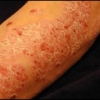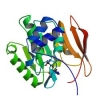TREM-1 come potenziale bersaglio terapeutico nella psoriasi
 Il nostro gruppo ha recentemente descritto una popolazione di cellule presentanti l'antigene, dette cellule dendritiche mieloidi infiammatorie (CD11c+/antigene 1− delle cellule dendritiche (DC) del sangue), che sembrano essere critiche per la patogenesi della psoriasi. La segnalazione attraverso il triggering receptor expressed on myeloid cells type-1 (TREM-1) è una delle vie di segnalazione più importanti nel trascrittoma di queste cellule.
Il nostro gruppo ha recentemente descritto una popolazione di cellule presentanti l'antigene, dette cellule dendritiche mieloidi infiammatorie (CD11c+/antigene 1− delle cellule dendritiche (DC) del sangue), che sembrano essere critiche per la patogenesi della psoriasi. La segnalazione attraverso il triggering receptor expressed on myeloid cells type-1 (TREM-1) è una delle vie di segnalazione più importanti nel trascrittoma di queste cellule.
TREM-1 è un membro della superfamiglia delle Ig, attivato dalla via di segnalazione DAP12, attraverso un ligando sconosciuto. L'attivazione tramite TREM-1 induce il rilascio di citochine infiammatorie, tra cui IL-8, MCP/CCL2 e il fattore di necrosi tumorale. Mostriamo che TREM-1 è espresso sia nella pelle di pazienti sani che di quelli psoriasici, e TREM-1 solubile si trova aumentato nel sangue periferico dei pazienti affetti da psoriasi.
Nelle lesioni psoriasiche, TREM-1 è stato localizzato sulle DCs, nonché sulle cellule endoteliali CD31+. L'espressione di TREM-1 è stata ridotta con successo attraverso i trattamenti a base di UVB a banda stretta (NB-UVB), etanercept e anti-IL-17. Al fine di studiare il blocco di TREM-1, è stato sviluppato un modello in vitro di monociti attivati dal peptidoglicano che funzionassero come le DCs mieloidi infiammatorie e oltre a questo, il trattamento con una chimera bloccante di TREM-1 ha diminuito l'attivazione allogenica delle cellule T-helper 17 e la produzione di IL-17: anche il blocco di TREM-1 delle DCs psoriasiche ex vivo in una reazione leucocitaria mista allogenica ha mostrato una diminuzione dell'IL-17.
Insieme, tutti questi dati suggeriscono che la via di segnalazione di TREM-1 può rappresentare un bersaglio terapeutico per prevenire gli effetti delle DCs mieloidi infiammatorie nella psoriasi.
Storia della pubblicazione:
Titolo: TREM-1 as a Potential Therapeutic Target in Psoriasis
Rivista: Journal of Investigative Dermatology (13 February 2013) doi| :10.1038/jid.2013.68
Autori: Luke A Hyder, Juana Gonzalez, Jamie L Harden, Leanne M Johnson-Huang, Lisa C Zaba, Katherine C Pierson, Narat J Eungdamrong, Tim Lentini, Nicholas Gulati, Judilyn Fuentes-Duculan, Mayte Suárez-Fariñas and Michelle A Lowes
Affiliazioni:
Abstract:
Our group recently described a population of antigen-presenting cells that appear to be critical in psoriasis pathogenesis, termed inflammatory myeloid dendritic cells (CD11c+/blood dendritic cell (DC) antigen 1−). Triggering receptor expressed on myeloid cells type-1 (TREM-1) signaling was a major canonical pathway in the published transcriptome of these cells. TREM-1 is a member of the Ig superfamily, active through the DAP12 signaling pathway, with an unknown ligand. Activation through TREM-1 induces inflammatory cytokines, including IL-8, MCP/CCL2, and tumor necrosis factor. We now show that TREM-1 was expressed in the skin of healthy and psoriatic patients, and there was increased soluble TREM-1 in the circulation of psoriasis patients. In psoriasis lesions, TREM-1 was colocalized with DCs, as well as CD31+ endothelial cells. TREM-1 expression was reduced with successful narrow band UVB (NB-UVB), etanercept, and anti-IL-17 treatments. An in vitro model of peptidoglycan-activated monocytes as inflammatory myeloid DCs was developed to study TREM-1 blockade, and treatment with a TREM-1 blocking chimera decreased allogeneic T-helper type 17 cell activation, as well as IL-17 production. Furthermore, TREM-1 blockade of ex vivo psoriatic DCs in an allogeneic mixed leukocyte reaction also showed a decrease in IL-17. Together, these data suggest that the TREM-1 signaling pathway may be a previously unidentified therapeutic target to prevent the effects of inflammatory myeloid DCs in psoriasis.




